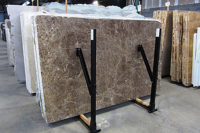Industry veteran Eric Tryon led an interactive discussion among a group of fabricators during a Stone Industry Education event held in the Pompano Beach, FL, area earlier this year. Among the many topics addressed was how to maximize remnants. In addition to physically managing leftover inventory, Tryon shared advice on how to get your entire team involved to save both money and waste.
When asked what can be done to utilize remnants, fabricators responded:
- Buy bundles
- Organize and don’t scratch them.
- Know what you have.
- Inventory.
“And here is the novel thing, you have to get up and physically see,” said Tryon. “You have to put your eyes on it and evaluate to see if it is going to work or not?”
Tryon explained how he implemented a plan involving his full workforce to help maximize slab usage and ways it benefited everyone. “There are ways we forced all of those things that an owner would do all the way down to the front liners,” he said. “We did it with the salesforce first, but also with the people who were close enough in the transaction to know.”
According to Tryon, the CAD and inventory purchasing person know what jobs are coming down the pipeline. He told the group he asked those staff members if they could have an ear and eye out for these things. “We told them that when you uncover them, get the department manager and let them know,” explained Tryon. “For example, the James job and the Stewart job are the same color, so instead of four slabs we can get three if we nest them. We just saved about $1,000.”
Tryon went on to say that the first month this program was put in place, his company saved 41 slabs. “We set it up to drive behavior,” he said. “For every slab saved, we put $50 into a pool. That was split by the three who were involved at the end of each month. So, we put out $2,000 the first month for performance bonuses to save $41,000. Pretty easy math. It’s not hard.”
Another successful tactic was to have the sales team be 100% commission only. “They only take commission off of their gross margins,” said Tryon. “Why gross margins and not topline? Material cost. So now they are looking at remnant usage – nesting jobs. They know we would allocate from an accounting perspective the cost of materials of the first job that the material was allocated to. If there were two slabs and we cut a slab and a half, that job burden is the material cost of those two slabs. That half of slab left over goes to the remnant yard and now has a material cost for any future sales job as $0. A salesperson figures this out really quick. If they go and sell this, there is zero material costs and they get paid a percentage on that gross margin. Now their number is larger, and they made a percent of that, so they made more money.”




